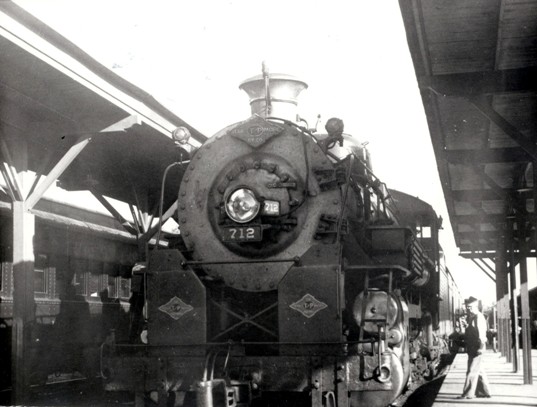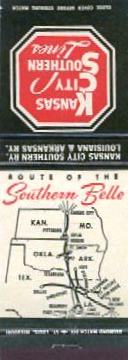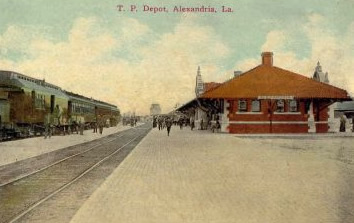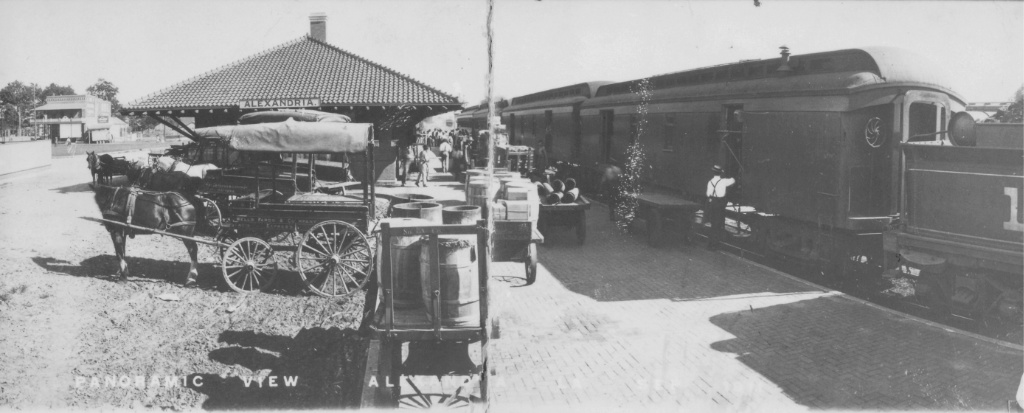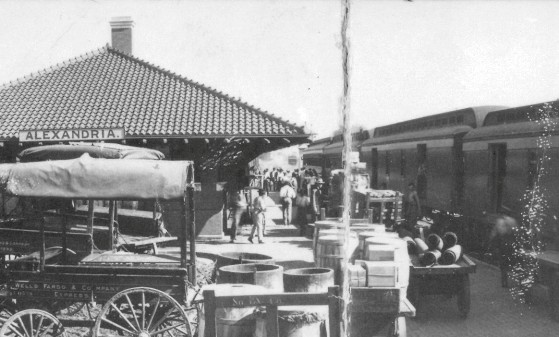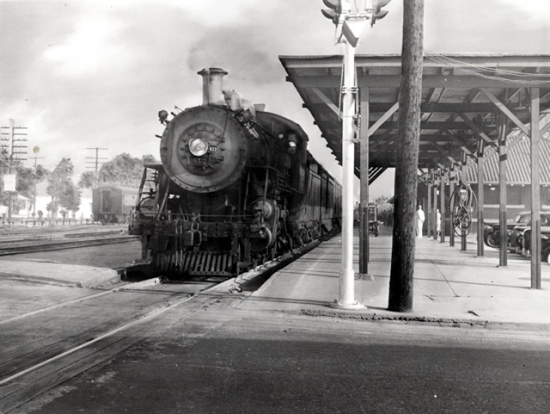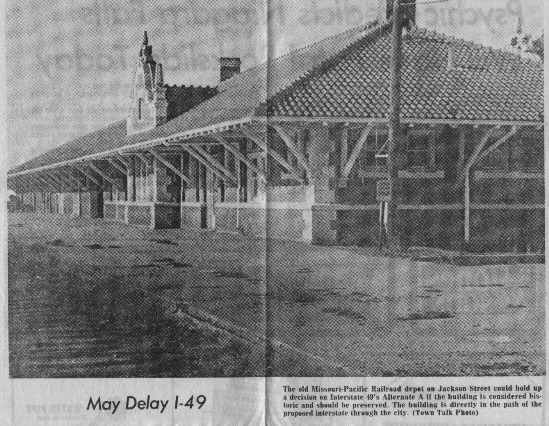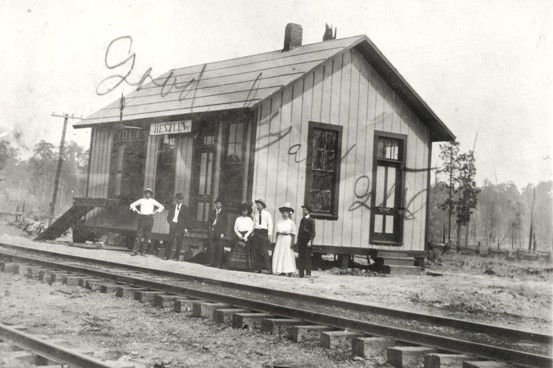Alexandria Louisiana Railroads
 Busy scene on Murray Street, looking towards the Red River, in Alexandria, Louisiana, in the early 1950s. The city was growing, and railroads played a key element in the expansion of the area. |
Alexander Fulton laid out the plan for Alexandria in 1805, and the settlement grew rapidly. Because of its strategic geographic location, which still holds true today, it became a center of transportation, trading, educaton, and agriculture.
Alexandria was in the center of massive native forest lands, much of which would ultimately be included in the Kisatchie National Forest. The growth of the lumber industry in the latter years of the 19th century and the opening of the area by the railroads allowed Alexandria to prosper immensely. Alexandria quickly became a major railroad center.
Alexandria, situated in Central Louisiana, has long been a railroad center. Among the railroads serving Alexandria over the decades:
- Missouri & Pacific Railroad
- Texas & Pacific (T&P) Railway
- Kansas City Southern (KCS)
- Louisiana & Arkansas (L&A) Railway and Louisiana Railway & Navigation Company (LR&N)
- Chicago, Rock Island & Pacific
- Southern Pacific Lines
- Union Pacific
- Alexandria and Western Railway
- Red River Railroad (Ralph Smith Smith Railroad)
- Red River & Gulf Railroad
- Claiborne-Polk Railroad
- various logging and sawmill railroads
Missouri Pacific Railroad (MoPac)
 Missouri Pacific ALCO Engine #8030 |
In early 1890, the Houston, Central Arkansas & Northern Railroad Company began construction at the Louisiana- Arkansas border and continued southward through Monroe to Alexandria. This section was completed in July 1892, and covered a distance of 145 miles.
In April 1893, this line was conveyed to the Alexandria and St. Louis Railway Co., and shortly afterwards to the St. Louis, Iron Mountain & Southern Railway Co.
The Iron Mountain had arrived in Central Louisiana in 1880. Five north of Pineville, Julius Levin built a sawmill next to the railroad. The town he named Levin was later changed to Tioga. On June 1, 1917 the Missouri Pacific Railroad Co absorbed the St. Louis, Iron Mountain & Southern Railway.
In 1997, the Missouri Pacific merged into the Union Pacific system.
 View of Missouri Pacific Eagle pulled by an EMD A-B-A E7 diesels like those seen in Alexandria |
Texas & Pacific (T&P) Railway
 Texas & Pacific Railway ... Route of the Eagles, serving the great Southwest |
 |
The Texas and Pacific Railway Company (T&P) was created by federal charter in 1871 with the purpose of building a southern transcontinental railroad between Marshall, Texas, and San Diego, California.
In the 1890s, the Texas and Pacific acquired several lines in Louisiana, and on September 12, 1882, finished a route from Shreveport to New Orleans.
The original Texas & Pacific Railway station in Alexandria was located at the corner of Tenth Street and Madison Street.
It was later replaced with Union Station, in use until the demise of passenger trains in Alexandria.
The T&P merged into the Missouri Pacific system on October 15, 1976.
|
 The "old" Texas & Pacific Railway depot at the corner of Madison and Tenth Streets in Alexandria, Louisiana (Louisiana History Museum) |
Texas & Pacific steam engine No. 712 at the Jackson Street crossing at Union Station railroad depot, Alexandria, Louisiana (Courtesy of Dale Geniuis and the Louisiana History Museum) |
Union Pacific Railroad
 |
Some of the railroads that have served Alexandria in the past have merged into other larger railroads. Both the Missouri Pacific and Texas & Pacific Railway have been merged into the Union Pacific Railroad, which today, in 2021, maintains a large presence in Alexandria.
No other railroad in the United States has retained its historical equipment and honored its past as much as the Union Pacific. The preservation of its fleet speaks to the high value UP places on its heritage and its role in America's history.
The fleet itself dates back to 1912, but most of the passenger cars are closer to a half-century old, built during the height of passenger train travel. Each car is unique and chronicles a different chapter of Union Pacific's past.
| Union Pacific Steam Engine 4014 and Excursion Trail (Staff Photos) | |
| "Experience the Union Pacific" on the UP Car Promontory  |
UP Dome Car "Walter Dean"  |
Louisiana and Arkansas (L&A) Railway
The original Louisiana & Arkansas Railway was begun by William Buchanan about 1896 to transport timber to his sawmills in Stamps, Arkansas. Over time he built the railway south and by 1898 had reached into north Louisiana. With acquisitions of other small railroads, Buchanan's railroad reached cities in Louisiana such as Minden, Cotton Valley, Sibley, Ashland and Winnfield.
In 1903 the railroad was extended north to Hope, Arkansas, where it connected with the Missouri Pacific and Frisco railroads. That same year the L&A stretched south to Jena, and in 1906 tracks were laid between Packton and Alexandria. Service to Alexandria began on July 1, 1906.
Another acquisition in 1910 added the route between Minden westward to Shreveport, and in 1917 leased trackage eastward to Vidalia.
 Early map of the Louisiana and Arkansas Railway, including the segment from Hope, Arkansas, south to Packton and Alexandria |
A new company was chartered in Delaware in 1928 to acquire the former Louisiana and Arkansas Railway Company, and to acquire and lease the Louisiana Railway and Navigation Company, that operated a marginally profitable railroad between New Orleans and Shreveport.
The construction of the Shreveport and Red River Valley Railroad was begun in 1896 by William Edenborn, and reached Alexandria in May of 1902. The railroad would later extend north to Winnfield, and south to Mansura and eventually New Orleans. Other acquisitions and arrangements extended the line into other parts of north Texas.
The L&A was consolidated into the Kansas City Southern Railway (KCS) on October 20, 1939.
Kansas City Southern (KCS)
 |
The Kansas City Southern Railway Company (KCS) had its origins in Kansas City in 1887, the brain child of Arthur Edward Stilwell. His grandfather, Hamblin Stilwell, was one of the founders of the New York Central Railroad, as well as a builder of the Erie Canal. With Edward Lowe Martin, Stillwell built the 40-mile long Kansas City Suburban Belt Railway, which began operations in 1890.
In 1889 Stillwell and Martin organized the Kansas City, Nevada and Fort Smith Railroad, intended to run south to Hume, Pittsburg (Kansas), Joplin (Missouri), and further south into Arkansas and Oklahoma.
By 1897 Stillway completed the Kansas City, Pittsburg & Gulf Railroad (KCP&G) running south from Kansas City to Shreveport and Port Arthur, Texas. Rail freight service began after the last spike was driven about 12 miles north of Beaumont, Texas, on September 11, 1897.
The KCP&G became the Kansas City Southern Rail Company (KCS) in 1900. KCS acquired the Louisiana and Arkansas Railway Company (L&A) in 1939. This acquisition added two more port cities, Baton Rouge and New Orleans, to the system as well as an east-west route into Dallas, Texas.
KCS in Alexandria
The KCS passenger depot was located just south of downtown Alexandria, on Third Street near its intersection with Casson Street.
KCS passenger depot in Alexandria, LA, February 11, 1978, prior to demolition (Staff Photo) |
KCS railroad trestle and girder bridge, Third Street, Alexandria, La., now removed (Staff Photo, August, 1976) |
The old swing-span railroad bridge over the nearby Red River was built in 1901 for the Louisiana Railway and Navigation Company. It was last used by KCS in January of 1996, and has been dismantled. Also, the approach, wooden trestle and steel overpasses over Second Street and Third Street have been removed, and the KCS passenger depot demolished (see images below). Concrete pillars supporting the overpasses remain.
|
The old KCS bridge has been replaced with a new high-level, fixed bridge about four miles south down river near Williams Lake on the east bank, near Latanier on the west bank. KCS also abandoned its rail yard in Alexandria, and moved it to Latanier (see map below).
Map showing new KCS Red River bridge near Latanier |
Map showing location of new KCS rail yard south of Latanier |
 Vintage postcard of the KCS Southern Belle ... "The Sweetheart of American Trains" |
KCS Southern Belle
KCS inaugurated the Southern Belle passenger train on September 2, 1940, from Kansas City to New Orleans, stopping in Alexandria as well as Joplin, Texarkana, Shreveport and Baton Rouge. The 861 mile trip took about 21.5 hours. Average speed was about 40mph.
Southern Belle trains were numbered KCS1 (southbound from Kansas City) and KCS2 (northbound from New Orleans). Other KCS passenger trains included "The Shreveporter" (Trains 3 and 4) and "The Flying Crow" (Trains 15 and 16).
KCS actively advertised the new train, including a beauty contest won by an 18-year-old Baton Rouge girl, Margaret Landry, who was named "Miss Southern Belle." Miss Landry became the spokeswoman for the new train, and was pictured on KCS timetable covers.
The Southern Belle's classic livery was Brunswick Green (often appearing black) with red and yellow trim. Rail car roofs were silver. The Belle was originally pulled by EMD E-3 diesel-electric locomotives.
 Miss Margaret Landry ... THE Southern Belle |
KCS kept passenger service even when it was losing money on the operation. Unlike most railroads, the KCS retained a positive view of passenger service into the 1960s, and provided passenger service as long as there were riders. KCS purchased used passenger cars as other railroads dropped service. In 1965, the KCS purchased ten new passenger coaches, the last railroad car purchase by a private U.S. railroad.
In Alexandria, the southbound Southern Belle, KCS 1, would back into the train station, while the northbound Southern Belle, KCS 2, would head directly into the station.
Our family frequently took rides at night in the summer to escape the Alexandria heat; one of our standard stops was to see the Southern Belle, KCS 2, at the KCS station on Third Street, around 8pm. Seeing the shiny black passenger cars, massive diesel engine, and observation car was always a thrill.
We would watch the Belle leave the station in reverse, and then move forward over the Third Street overpass and cross the Red River heading north.
Often we would then ride over to Pineville and watch the Southern Belle cross the Main Street overpass near Louisiana College as it gained speed for its run to Shreveport, and beyond.
KCS Railway overpass on Main Street in Pineville, Louisiana, circa 2000 (Staff Photo) |
Present-day Kansas City Southern Railway overpass on Main Street in Pineville, Louisiana, near the entrance to Louisiana College
 |
Typical Rail Cars on the Southern Belle |
|
KCS Pullman car "Stuart Knott" built by Pullman-Standard in 1948 |
KCS coach 279, built in 1965 |
KCS tavern-lounge-observation club car KCS55 "Hospitality" |
Typical Southern Belle consist  |
KCS Later Years ... and the Business Train
 KCS 1 "Meridian" in Baton Rouge, Lousiana, June of 2000 (Staff Photo) |
Southern Belle service ended on November 2, 1969 as passenger volume dropped, and contracts were terminated by the Postal Service a nd REA.
In 1995 KCS revived the Southern Belle as the railroad's new business train. KCS purchased four former Canadian National FP9 locomotives for the train. The FP9 was essentially EMD's F9 locomotive extended by four feet to give greater steam generator and water capacity for hauling passenger trains. These engines were painted in the KCS classic dark livery of Brunswick Green with red and yellow trim. They were originally numbered as follows:
- KCS 1 - Meridian - EMD FP9A
- KCS 2 - Shreveport - EMD FP9A
- KCS 3 - Pittsburgh - EMD F9B
- KCS 4 - Vicksburg - EMD FP9A
In 2001, KCS 1 and KCS 2 numbers were swapped, since KCS 2 had air conditioning, and became the lead unit, leaving the configuration as follows:
- KCS 1 - Shreveport - EMD FP9A
- KCS 2 - Meridian - EMD FP9A
- KCS 3 - Pittsburgh - EMD F9B
- KCS 4 - Vicksburg - EMD FP9A
In 2002 the business train engine fleet was repainted in the classic "Southern Belle" livery.
KCS 4 was later transferred to the Kansas City Union Station for display, and renumbered KCS 34.
|
 KCS locomotives in new paint scheme (Photo courtesy of KCS) |
 KCS 1 ... "Shreveport" |
Kansas City Southern in 2007 starting using the popular, classic KCS Southern Belle paint scheme on all of its motive power.
It also operates the Holiday Express, making stops throughout the KCS system. The 11th Annual Holiday Express headed by the KCS Southern Belle Business Train, scheduled a stop in Pineville across the Red River from Alexandria on December 1, 2011. It was again in Pineville on December 2, 2019, at the entrance to the Louisiana College Baseball Field, at 910 Melrose Street.
Canadian Pacific Kansas City (CPKC)
On April 14, 2023, purchase of the KCS by Canadian Pacific (CP) was completed, forming the CPKC Railroad. The railroad became the first and only transnational rail network in North America, linking Canada, the United States and Mexico.
KCS-L&A Timetable August 15, 1943 |
KCS Southern Belle Matchbook Cover |
KCS Ad in the Alexandria Daily Town Talk in 1957 during Alexandria's Sesqui-Centennial. Ticket Office ... Tel 2-3386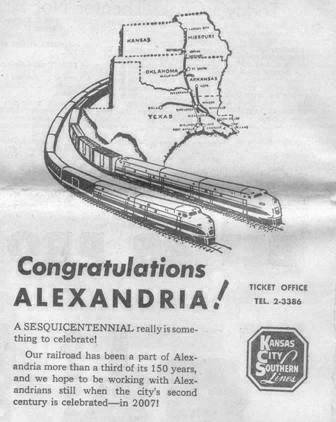 |
Chicago, Rock Island and Pacific
 |
The Chicago, Rock Island and Pacific Railway (CRI&P), also known as the Rock Island, or the Rock, was a class 1 railroad running west, southwest and northwest from Chicago. The railway was chartered in 1847 as the Rock Island and LaSalle, and later it was decided the line should stretch into Chicago. Over the years it expanded to many states, and fell into bankruptcy. By 1984 all assets had been sold, and the line ceased to exist.
One line ran from Little Rock, Arkansas to the south, through Junction City, Ruston, Hodge, Jonesboro, Winnfield, Packton, and then into Alexandria. The Rock Island line paralleled the adjacent Louisiana & Arkansas (L&A) Railroad trackage, which also ran through Winnfield and Packton. Located at Packton was "L&A Junction", where the Rock Island connected with the L&A and used its trackage rights on the L&A south to Alexandria. When the trackage rights on the L&A were extended northwards to Winnfield, this line was abandoned.
To the south of Alexandria, the Rock Island had extended it service through LeCompte to Eunice, a distance of about 60 miles, by 1913.
Southern Pacific
 |
Southern Pacific (SP) began in 1865 as a land holding company, and by 1900 it had grown into a major railroad system incorporating many smaller companies such as the Texas and New Orleans Railroad and the Louisiana and Texas Railroad. SP merged with the Union Pacific Railroad in 1996.
One section of the SP was the "Alexandria Branch" which ran from Alexandria south to Gold Dust, Opelousas, Sunset, Carencro, Baton Rouge Junction, and Lafayette (main line).
Southern Pacific started running twice-daily passenger trains between Alexandria and New Orleans in November of 1909. Beginning in 1916, SP also offered passenger service to Lafayette.
The SP abandoned its Alexandria Branch in November of 1984, along with its Alexandria rail yard.
SP Railroad depot, Third Street at the levee, Alexandria, Louisiana, August, 1976 (Staff Photo) |
Close-up, Southern Pacific railroad depot, across Third Street from the KCS depot, Alexandria, Louisiana, February 11, 1978 (Staff Photo) |
 Alexandria & Western Railway Engine No. 10 |
Alexandria and Western Railway
A regional railroad, the Alexandria & Western Railway, began operation in 1909, extending from a terminal at Second and Lee Streets, along the city's trolley tracks, and then westward along Bayou Rapides. Its destination was a point in Texas, and its primary cargo was timber for area sawmills.
It was owned by the principals of the Albert Hanson Lumber Co of Garden City, LA. Construction began in 1913, and the line eventually reached Gardner.
On one map, and one historical resource, there is reference to a depot of the Alexandria & Western Railway at Second Street near present-day Broadway Avenue. It was reportedly located at the southern end of the "Depot Line" of the electric trolley system.
It ceased operations in 1925.
Many other logging operations and sawmills were located in the Alexandria area over the years, and many ran railroads, such as the Crowell & Spencer Lumber Co., Urania Lumber Company, Caddo-Rapides Lumber Company, Enterprise Lumber Company, Long Pine Lumber, Iatt Lumber, Ferd Brenner Lumber Co., and the J. A. Bentley Lumber Company at Zimmerman.
Ralph Smith Smith Railroad
 Historical Marker about the Smith Smith Railroad |
In the early 1800s, planters in the area south of Alexandria had difficulty in getting their crops to market due to fluctuating water levels and the narrow, twisting turns of Bayou Bouef. An area engineer, Ralph Smith Smith, decided a railroad was the solution to the farmers' plight.
He developed a 16-mile-long railroad, circa 1840, following Bayou Bouef for the most part, to connect Smith's Landing (near present day Lecompte) to the docks at Alexandria. The Red River Railroad, also known as the Ralph Smith Smith Railroad and the Alexandria & Cheneyville Railroad, was the first railroad built west of the Mississippi River.
Though crudely built and very slow, Smith's train could make one round trip a day, and was in operation for over twenty years. In 1854 Smith's Landing was renamed Lecomte, in honor of the famous racehorse.
The railroad was destroyed in 1864 during the Civil War. In 1881, Smith sold his railroad to the New Orleans Pacific Railway Company. Ralph Smith Smith, born in 1806, died in Alexandria in 1883.
Union Depot in Alexandria
Design work began in 1907 for a new station to support operations of the Missouri Pacific and Texas & Pacific. Construction continued at a slow pace for three years, and the new Union Station Depot was opened in December of 1909, at the corner of Jackson Street and Tenth Street, about five blocks south of the previous station.
The bungalow-style pressed-brick structure featured a red tile roof and detailed architectural features (see blueprint below).
A green space with grass and trees was located just to the east of the depot. The building was enlarged and improved in 1941 to meet the needs of the thousands of soldiers training at area military bases such as Camp Claiborne and Camp Livingston.
The depot served the MP and T&P through the 1960s when passenger rail service to Alexandria was terminated.
 Aerial view of downtown Alexandria, Louisiana, looking east, showing the location of Union Depot, the Red River and the KCS Bridge (upper right) |
 Aerial view of the former location of Union Depot at the corner of Jackson and Tenth Streets in Alexandria, Louisiana |
 A closer aerial view of the location of Union Station, circa early 1950s. Also visible is the European Hotel, the park and the little building on the middle right that became Jimmy's Barbeque, as well as Rapides Grocery Company (Photo courtesy of Dale Genius and the Louisiana History Museum) |
 Architectural drawing of the detailed features of Union Depot in Alexandria |
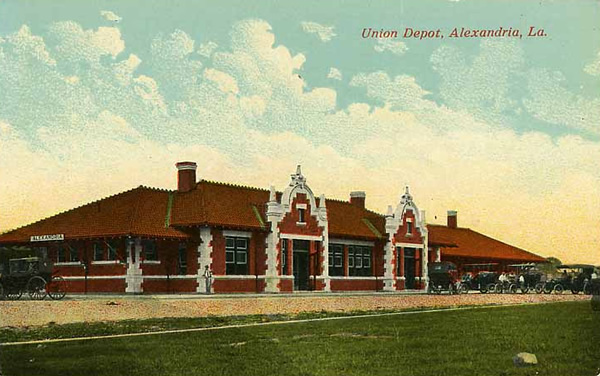 Vintage Postcard of the completed Union Depot, Jackson Street and Tenth Street, Alexandria, La. |
New Union Station, Alexandria, LA, seen from the railroad tracks, looking north (Staff Historical Collection) |
|||||||||
(Courtesy of Dale Genius and the Louisiana History Museum) |
|||||||||
Union Station, Alexandria, Louisiana, circa 1910-15, with Wells Fargo & Co. wagon meeting the northbound train (Courtesy of the Louisiana History Museum) |
|||||||||
Steam engine at Union Station railroad depot, Alexandria, Louisiana, circa 1937-1940 (Courtesy of the Louisiana History Museum) |
|||||||||
 Union Depot in Alexandria, Louisiana ... abandoned and awaiting demolition for the construction of I-49 |
|||||||||
The end of the line for Alexandria Union Station February 11, 1978, prior to demolition for I-49 (Staff Photos) |
 |
||||||||
 Officials discuss the fate of the former Missouri-Pacific Railroad depot, which is in the path of the proposed Alternate A route of Interstate 49. It is also possibly eligible to be deemed a "historic" place by the National Register of Historic Places. Examining the depot are (from left) Duke Rivet, State Department of Transportation & Development (DOTD), Dave Cox of the Federal Highway Administration, and Jonathan Fricker of the state division on historic sites. (Town Talk Photo) |
|||||||||
The old Missouri-Pacific depot in Alexandria, Louisiana on Jackson Street could hold up a decision on Interstate 49's Alternate A route if the building is considered historic and should be preserved. The building is directly in the path of the proposed interstate through the city. (Town Talk Photo, July 22, 1979) |
|||||||||
|
|||||||||
More Photos of Alexandria Railroad History
|
||
Bentley, Louisiana railroad station, just outside Alexandria - Circa 1910-1915 (Courtesy of the Louisiana History Museum) |
||
|
||
Places to Eat and Drink Around the Railroads During World War II |
||
 |
 |
 |
The Alexandria Electric Railway Company
Alexandria had other rail systems in addition to a number of railroads ... like the Alexandria Electric Railway Company! Early trolleys were pulled by mules, and later were electrified. Read about Alexandria Louisiana Streetcars and Electric Trolleys
Railroading Memories from Earlier Times
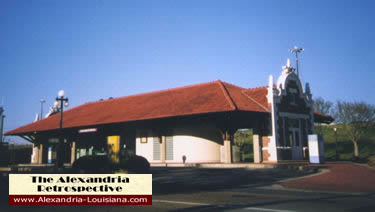 Relocated Union Station depot facade at the Alexandria transportation center on 2nd Street (Staff Photo) |
Alexandria and the railroads have maintained a tight relationship over the years. The railroads employed many in Alexandria, including my grandfather, Joseph Leo Bourg, Sr., who worked for the Rock Island. My great-grandmother ran a boarding house at 424 Wheelock Avenue, less than two blocks from Central Depot. In the dozen houses on our block in the 1950s, two were railroad employees. My uncle Doyle S. Gibson also worked for the railroad, on the Cotton Belt Route, in Arkansas and Texas.
By the time I became aware of railroads in the mid-1950s, much history had already past, and my memories are from a short slice of time between 1955 and 1968.
I do recall the thundering noise of the Missouri-Pacific Alco PA "long nose" diesels as they pulled into the station and literally shook the ground. And those warm summer nights with the family watching the northbound KCS Southern Belle at the Third Street Station!
Union Station, rotting away from years of neglect, was torn down during the construction of I-49. Its facade was saved, and moved to the new transportation center downtown at the corner of Murray and Second Streets at the Red River levee.
Railroad Links & Resources of Interest
Missouri-Pacific Historical Society
Texas & Pacific Railway History and Photos
CPKC Railroad Corporate Website
Louisiana History Museum in Alexandria
St. Louis Southwestern Railway - Cotton Belt Route - in Tyler Texas
Tyler Southeastern Railway and Cotton Belt in Gresham, Flint, Bullard and Jacksonville Texas
Southern Forest Heritage Museum - Long Leaf, Louisiana


